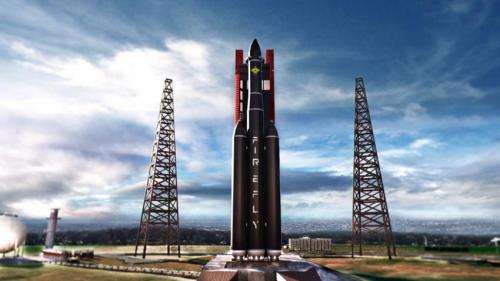July 9, 2014 weblog
Satellite launch company FireFly aims to lighten costs

(Phys.org) —Satellite launch company FireFly Space Systems, with locations in Austin, Texas and Hawthorne, California, founded early this year, is on a mission: Cut the costs for lighter loads going to low Earth orbit. The company said in setting out to do business there was a governing goal, to "create the lowest cost vehicle with the highest performance possible." What kinds of lighter loads are they talking about? New Scientist said, for example, the loads would be in the form of constellations of small satellites used for communications networks, or monitoring Earth. Once their mission is accomplished, a playing field, so to speak, may be evened out. New Scientist said that currently most probes like this piggyback into space on larger missions that can afford to fly on big rockets. The smaller-size operators have a limited choice of launch dates and orbits, said the report.
The young company is barreling ahead, and has revealed the design of the FireFly Alpha, a vehicle that aims to launch lightweight satellites at low cost. The team said the goal is "to lower the prohibitively high costs of small satellite launches to Low Earth and Sun Synchronous Orbits." FireFly Alpha "is the first vehicle in a scalable family of launchers specifically designed to address the needs of the light satellite (< 1,000kg) community," according to the company, which said the vehicle is capable of carrying 400kg into low Earth orbit.
So how is the vehicle structured? A key feature about their design is its aerospike. A wedge-shaped nozzle delivers thrust; the team is not using the traditional bell-shape nozzle. The company team pointed out on the site that the bell nozzle in conventional rockets represents lost weight from a payload standpoint. Also, "traditional bell nozzles are a compromise; while they are effective at optimizing thrust for a given external air pressure, they are less efficient at other points during the rocket's trajectory."
Another notable feature is the use of methane. The company said that while it has never been used on an orbital launch vehicle, the attraction of methane was undeniable. "The fuel is readily available and clean burning when compared to a solid, kerosene or hybrid engine. It's also easy to store, transport, and is inexpensive." Engines require an inert pressurant, typically helium, to drive fuel and oxygen into the combustion chamber, but this adds weight and costs that FireFly seeks to avoid. FireFly's engines are self-pressurized. The fuel itself is used to provide the working pressure for the engine. This, said the team, simplifies design and saves weight.
All in all, the FireFly Alpha represents lowered launch prices. Firefly CEO Thomas Markusic said, "We are offering small satellite customers the launch they need for a fraction of that, around $8 or 9 million – the lowest cost in the world. It's far cheaper than the alternatives, without the headaches of a multi manifest launch."
The team at FireFly includes aerospace engineers from companies such as SpaceX, Blue Origin and Virgin Galactic.
Back in January, co founder Michael Blum, in announcing the start of the company, said, "What we are setting out to do will be enormously challenging. It is difficult to make exact projections about schedule until we get further along in development, but the team has set itself a goal: To be in orbit in about three years."
More information: www.fireflyspace.com/vehicles/firefly-a
© 2014 Phys.org. All rights reserved.




















